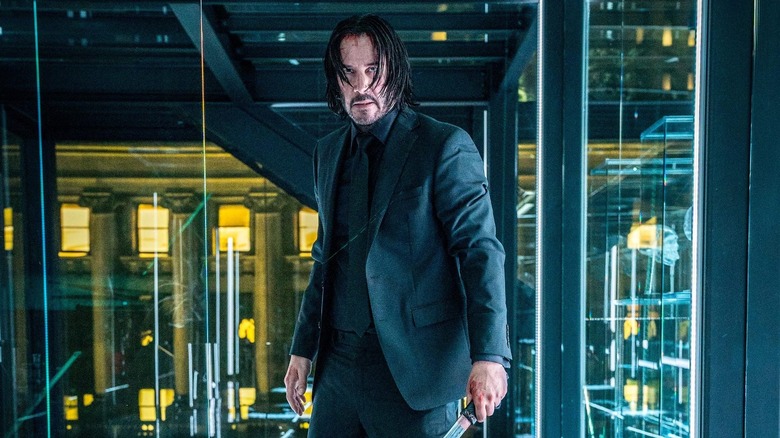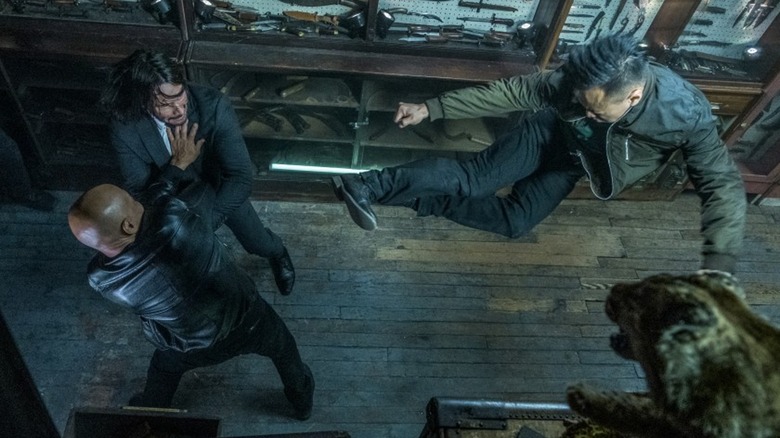The Toughest Visual Effect In John Wick Films Isn't Explosions – It's Knives
This post contains spoilers for "John Wick: Chapter 3 — Parabellum."
Slick, visceral kineticism and mind-blowingly impressive gun-fu are integral to every fight John Wick (Keanu Reeves) gets involved with. Throughout the four "John Wick" films, dynamism has been the name of the game in terms of one-upping fight scenes, where everything from cars, pencils, explosives, and even stairs have been incorporated to keep the adrenaline flowing. In "John Wick: Chapter 3 — Parabellum," John is the definition of a marked man, hounded by every assassin across the globe after breaking the rules, and he stumbles into a weapons shop with cramped rooms. After a few assassins corner him inside, there is but one option left: improvise and adapt with the countless antique knives displayed on glass panels to overcome a monumentally messed-up situation.
Even though "Parabellum" boasts several memorial fight scenes, the knife fight is a clear standout, and /Film's Jeremy Mathai goes into meticulous detail to explain why in this "Best Action Scene Ever" column pick. A balanced mix of realistic combat (where not every knife throw sticks a landing, especially in such a desperate scenario) and comedic punctuations makes this scene come alive, allowing us to witness John's ability to improvise with any weapon in his vicinity, even when he's not doing too well. Glass panels are shattered without a care in the world, and the repetition of this act becomes a running gag that ties the scene together neatly, right up till the knives land exactly where they're supposed to, or find their way to targets in satisfying physics-defying ways.
Filming such high-octane, close-quarters fights with knives, even rubberized ones, can be very tricky, and "Parabellum" VFX Supervisor Rob Nederhorst told Vulture about the labor-intensive digitization of the weapons in these scenes to ensure cast and crew safety.
The John Wick VFX team went all in on fake knives
Nederhorst explained that rubberized knives, which are essentially prop knives used in films, are realistic molds of real weapons. Not only do these props look "indistinguishable from the real thing," but also allow a ton of flexibility during intense scenes while ensuring on-set safety. However, these rubber knives can potentially cut someone when brandished quickly, and Nederhorst's solution for this was for actors to only use the knife handle so that the team could digitize the knife in post:
"Instead, we make a handle, so the performer has something to grip on to. And then we match-move them on a computer and put a knife in there digitally. Ninety-five percent of the knives you see in 'John Wick 3' are digital. In the case of throwing knives, we won't even have a handle — people will mime out the throw, mime the catch, and mime someone getting hit. It's all mimed out and rehearsed meticulously."
This highlights the intensely thorough approach that went into planning and polishing these scenes, as match-moving mimed back-and-forths in digital demands incredible care and attention to detail, as everything needs to look seamless in each frame. Nederhorst also revealed that rehearsals played an equally important role here, where the stuntpersons figured out the best way to move about to make the choreographed action seem fluid and instinctive. A lot of work also went into "super-photogenic" data captures of every person involved:
"I'm really fussy about data capture...We scan all the performers and all the knives, and get complete, super-photogenic versions of every single person and prop, so we can re-create them digitally. If you want it to look real, you need real-world measurements...You need to do the work."
That sounds about right, as the results speak for themselves.

